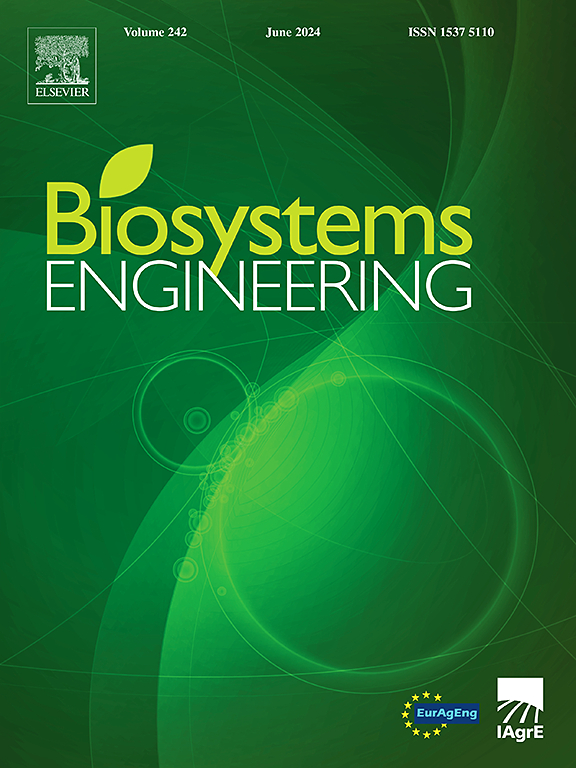基于近红外光谱增强和重建架构的农产品糖含量预测模型的标定转移
IF 5.3
1区 农林科学
Q1 AGRICULTURAL ENGINEERING
引用次数: 0
摘要
梨和甘蔗等农产品中糖含量的快速无损测定对于优化收获时机和提高市场竞争力至关重要。然而,基于近红外光谱的预测模型在跨年或跨设备转移期间泛化性能下降,主要原因是样本量不足和光谱可变性,这极大地阻碍了它们在农业工程中的大规模部署。为了解决这些挑战,本研究提出了一种新的频谱掩膜自编码器生成对抗网络(SMAEGAN),该网络将对抗训练与掩膜自编码器策略相结合,以合成具有增强跨域泛化能力的高保真频谱数据,从而有效缓解了少量迁移学习场景中的数据稀缺性。此外,还介绍了一种金字塔关联自关注光谱转换器(PASASpTr),该转换器通过创新的金字塔结构分层提取多尺度光谱特征,从而实现局部波段特定变化和全局模式的协同捕获。综合实验评估表明,PASASpTr在甘蔗糖含量预测方面显著优于传统卷积神经网络,其均方根误差(RMSE)为3.40,决定系数(R2)为0.93,参数大小为0.94 m。结合smaegan增强重建光谱进行迁移学习,在不同设备采集的甘蔗数据集上,平均RMSE降低44.68%。在不同年份和不同生产线收集的梨数据集中,平均RMSE降低了40.65%。该方法架构显著减少了对目标域注释样本的依赖,同时为预测各种农产品的糖含量提供了轻量级和可扩展的解决方案。本文章由计算机程序翻译,如有差异,请以英文原文为准。
Calibration transfer of sugar content prediction models for agricultural products via NIR spectral augmentation and reconstruction architecture
Rapid non-destructive determination of sugar content in agricultural products such as pear and sugarcane is critical for optimising harvest timing and enhancing market competitiveness. However, near infrared spectroscopy-based prediction models suffer from degraded generalisation performance during cross-year or cross-device transfers, primarily due to insufficient sample sizes and spectral variability, which significantly hinders their large-scale deployment in agricultural engineering. To address these challenges, this study proposes a novel spectral masked autoencoder generative adversarial network (SMAEGAN), which integrates adversarial training with a masked autoencoder strategy to synthesise high-fidelity spectral data with enhanced cross-domain generalisation capabilities, thereby effectively mitigating data scarcity in few-shot transfer learning scenarios. Furthermore, a pyramid associative self-attention spectral transformer (PASASpTr) was introduced that hierarchically extracts multi-scale spectral features through an innovative pyramid architecture, enabling the synergistic capture of both local band-specific variations and global patterns. Comprehensive experimental evaluations demonstrate that PASASpTr significantly outperforms traditional convolutional neural networks in sugarcane sugar content prediction, achieving a root mean square error (RMSE) of 3.40, a coefficient of determination (R2) of 0.93, and a parameter size of 0.94 M. When combined with SMAEGAN-augmented reconstructed spectra for transfer learning, an average RMSE reduction of 44.68 % was achieved in the sugarcane dataset collected across different devices, and an average RMSE reduction of 40.65 % was achieved in the pear dataset collected across different years and production lines. This methodological architecture significantly reduces the reliance on target-domain annotated samples, while offering a lightweight and scalable solution for predicting sugar content across a wide range of agricultural products.
求助全文
通过发布文献求助,成功后即可免费获取论文全文。
去求助
来源期刊

Biosystems Engineering
农林科学-农业工程
CiteScore
10.60
自引率
7.80%
发文量
239
审稿时长
53 days
期刊介绍:
Biosystems Engineering publishes research in engineering and the physical sciences that represent advances in understanding or modelling of the performance of biological systems for sustainable developments in land use and the environment, agriculture and amenity, bioproduction processes and the food chain. The subject matter of the journal reflects the wide range and interdisciplinary nature of research in engineering for biological systems.
 求助内容:
求助内容: 应助结果提醒方式:
应助结果提醒方式:


